1938 Peugeot 402 Darl'mat Special Sport
1938 Peugeot 402 Darl’mat Special Sport
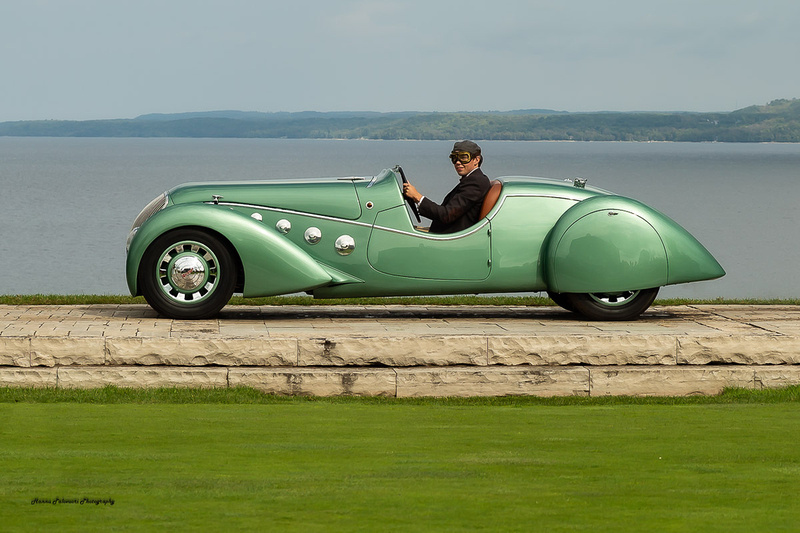

-“ The speed of a racing car, the comfort of a touring car, the budget of a production car”-
Look at it. Keep looking. Soak it in? If this car does not evoke something in your car loving soul, then this article is not for you. It is okay, as I imagine everyone is still here because of the car features so many timeless design elements as to be almost universally desirable in some way.
This marvelous automobile was at Cobble Beach Concours d'Elegance in 2023, where it placed 2:nd in the category of European Full-Classics 1915 to 1948. It is owned by Mary and Ted Stahl of Chesterfield, Michigan, USA.
The car’s fabulous shape was drawn by Georges Paulin and fabricated from sheet aluminum by Marcel Pourtout, for Emile Darl’Mat, whose Paris based company was one of the world’s largest Peugeot agencies.
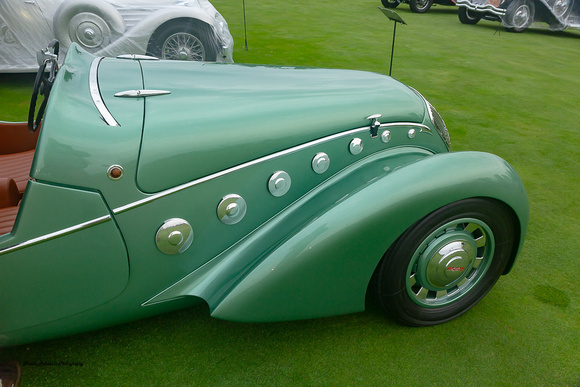

Behind the large, domed grille, reminiscent of a knight’s helmet, the lines stretch out, fluid and elegant, as if marrying the streams of air flowing over the body and rear wheel arches in their own quest for the optimum profile.
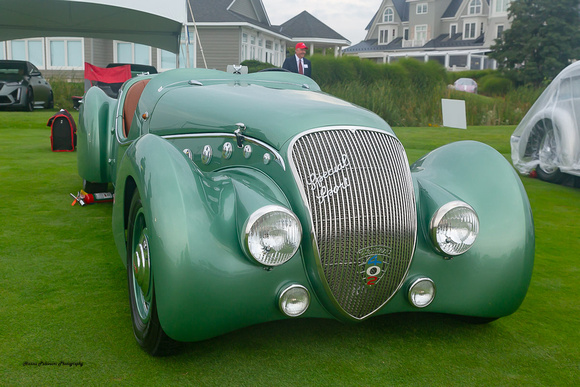

Ahead is a simple dashboard, in polished aluminum, (in this case body color), with two large dials and several smaller instruments: in addition to a rev counter that, curiously, runs back-to-front, there is an oil-temperature gauge, which is also rather unusual and serves to convey the inherent sportiness of this machine.




A discreet electric pump has been added to allow the carburetors to be primed without pulling the starter
Under the dashboard is a reverse/neutral/forward lever that, after disengaging the clutch, is placed in forward gear.
First is then selected via a short lever on the dashboard – some examples feature the classic Cotal ‘mustard pot’ electromagnetic gearbox – and to pull away you simply engage the clutch quite normally.
Second is selected by declutching again and moving the dashboard lever, and so on up to fourth.
Clutchless shifts into third and fourth are possible.
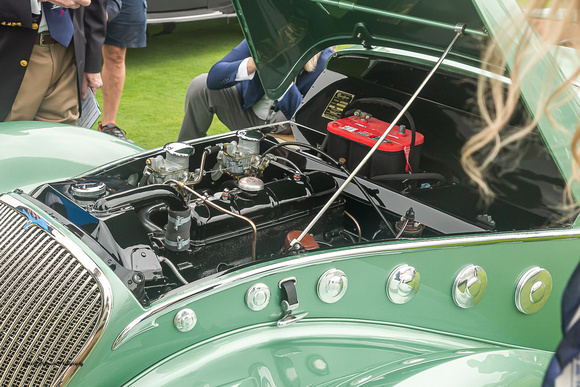

The 1,991cc four-cylinder overhead camshaft engine powering the Darl'Mat-built Peugeots produced approximately 70 horsepower, with later-built examples receiving the 402B designation and powered by a 2,142cc unit. The Cotal four-speed electro-mechanical gearbox could be operated via a selector lever positioned directly behind the steering wheel. Cable-operated drums provided braking. Suspension in the front was independent with transverse, semi-elliptical springs and hydraulic shocks. The rear suspension was similar, but with a live axle.


The Paulin-designed bodies were built by Pourtout from pieces of sheet aluminum hand-shaped and nailed to wooden structures of ash framing before being fitted to the chassis. The styling was aerodynamically efficient, resulting in higher top speeds and better fuel economy. The the innovative—and hugely stylistically-impactful—retractable windshield that the racing and roadster versions of the Darl’Mat design featured. This ensures that the designers clean, aerodynamic, beautiful lines can be preserved, while drivers have the obvious utility that a windshield provides. In accordance of the rules set by Le Mans 24 hrs race, cars had to have a wind screen. This detail did not enamor the designer, because it took away from the wind sculpted lines of the car. Loop hole in the regulations was found, that the car only needed a wind screen at the start of the race, which made retractable wind screen viable.




The bodies had flowing lines, teardrop-winged shapes, a vestigial boat-tail rear end, medallion-shaped hood side vents, heart-shaped rear license plate housing, and a gently sloping grille. The car also has a canvas top, stowed behind the backrest in a luggage compartment from which the hood sticks unfold. At the rear of the car, where a round cover hides the spare wheel; beneath it sits the heart-shaped numberplate, which further attests to the care taken in the finish of the car. The designs created for Darl'Mat reflected his passion for speed and motorsports, a legacy that Peugeot had fostered before switching to pedestrian models. Peugeot had built many successful Grand Prix cars prior to World War I, with accolades that included a victory at the 1916 Indianapolis 500. Privateer André Boillot drove Peugeots to victory at the 1919 Targa Florio, the 1922 and 1925 Coppa Florio, the 1923 and 1925 Touring Car Grand Prix, and the 1926 24 Hours of Spa.
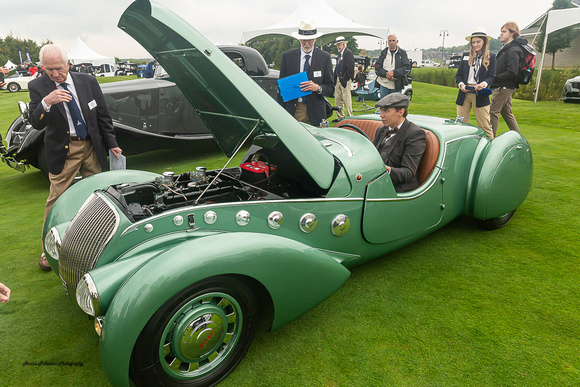

By 1938 Peugeot had introduced a 402 Legere chassis which became the foundation for the later cars. These had a shortened and widened chassis but retained the same 2-litre engine.
Émile Darl'mat (1892–1970) was the creator and owner of a Peugeot distributor with a car body business established at the rue de l'Université in Paris in 1923.[1] In the 1930s the firm gained prominence as a low volume manufacturer of Peugeot-based sports cars
Darl’mat was a passionate mechanic who embarked on a career in the motor trade in 1920s Paris. He soon devoted himself exclusively to Peugeot, and brought his inventiveness to the rather traditional Peugeot marque. Assuming the role of a dealer/designer/producer much in the same vein as Steve Saleen has taken with Ford and its Mustang. Darl'Mat was a passionate champion of the Peugeot marque and longed for it to return to racing, particularly at prestigious home events like the 24 Heures du Mans. Using his considerable influence, he obtained the factory's blessing for a limited run of sports cars worthy of Peugeot's sporting legacy. He was one of a select few dealers able to offer custom coachwork to his customers, and Peugeot was more than happy to supply him with whatever he needed, so long as the orders kept rolling in.
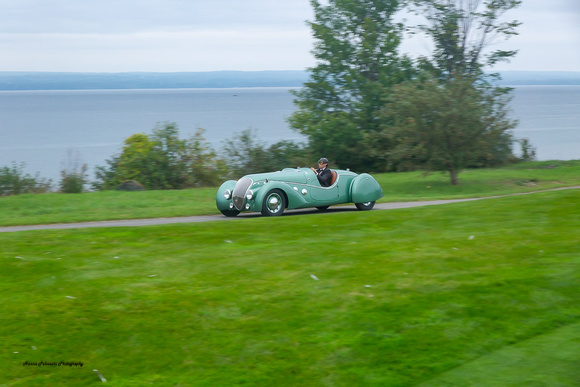

Georges Paulin started work as a dental technician but remained passionate about aerodynamics and design, to which he devoted more and more time.
He made a name for himself in 1932 with a patent for a retractable roof, which was adopted by Peugeot on its 301 Éclipse, bodied in the workshops of Marcel Pourtout.
Paulin designed several models, each of which was characterised by the quest for optimum aerodynamic streamlining (typically in order to compensate for a sometimes modest power output).
With Peugeot’s hiring of Georges Paulin—the last part of the name—ensured that Darl’Mat could achieve these dreams. M. Paulin almost instantly began collaboration with the Darl’Mat company and their racing projects, bringing a modicum of factory support to the table. Georges Paulin started work as a dental technician but remained passionate about aerodynamics and design, to which he devoted more and more time.
He made a name for himself in 1932 with a patent for a retractable roof, which was adopted by Peugeot on its 301 Éclipse, bodied in the workshops of Marcel Pourtout.
Paulin designed several models, each of which was characterised by the quest for optimum aerodynamic streamlining (typically in order to compensate for a sometimes modest power output).
Marcel Pourtout had founded his coachbuilding business in 1925 and produced unremarkable designs at first, though that all changed when he was joined by Georges Paulin. A dentist by profession, Paulin understood aerodynamics and had impeccable taste. He worked for Panhard, Unic and Peugeot, for whom he designed the 1934 'Eclipse' featuring a retractable steel cabriolet roof, a construction he patented.
Pourtout built around 105 of these streamlined cars for Darl'Mat between 1936 and 1939 (53 roadsters, 20 coupés, and 32 convertibles) and examples of the roadster ran competitively at Le Mans in 1937 and 1938.
Aided by Peugeot’s Director of Mechanical Studies, Alfred Geauque, Paulin specified that the 1.99L 4-cylinder engine was modified for race duty, while the chassis was both widened and shortened, to result in a wheelbase of 113.4 inches.
The most famous result of these racing efforts was the 1938 24 Hours of Le’Mans, where three Darl’Mat entries started on the line. While two of these cars were forced to throw in the towel, with this, the sole remaining racer won 4th overall, and taking first in the 2.0L range. On top of that, the finishing entry was also rewarded the coveted Le’Mans Index of Performance. More advanced engine preparation including light alloy cylinder head brought the horsepower close to producing 90bhp at 4500rpm.
The majesty of the vehicle remained intact through the production of the car, although there were more body styles offered than the Roadster-style of the racing effort. As the result of this, about 105 and were made, numbering 53 roadsters, 20 coupes, and 32 soft-top cabriolets. There are estimated 30 survivors
The nutshell
Peugeot 402 Spécial Sport
- Sold/number built 1937-’38/105 (302 and 402 DS)
- Construction ‘Bloctube’ steel chassis, steel body with aluminum bonnet
- Engine all-iron, ohv 1991cc ‘four’, single or twin Zenith-Stromberg carburetors
- Max power 70bhp @ 4500rpm
- Max torque n/a
- Transmission three-speed manual or four-speed Cotal electromagnetic, RWD
- Suspension: front independent, by lower links, transverse leaf spring rear live axle, semi-elliptic leaf springs; lever-arm dampers f/r
- Steering worm and sector
- Brakes cable-operated Bendix drums
- Length 13ft 9½in (4200mm)
- Width 5ft 6in (1680mm)
- Height 3ft 7¼in (1100mm)
- Wheelbase 9ft 5in (2880mm)
- Weight 1654lb (750kg)
- 0-60mph n/a
- Top speed 100mph (est)
Refrences:
1938 Peugeot 402 Darl'mat ‘Special Sport’ (supercars.net)
https://en.wikipedia.org/wiki/Darl%27mat
Peugeot 402 Spécial Sport: Darl’mat’s Le Mans dream | Classic & Sports Car (classicandsportscar.com)
Bonhams Cars : 1938 Peugeot 402 Darl'Mat Special Sport Chassis no. 400233 (see text)
1938 Peugeot 402 Darlmat Pourtout - conceptcarz.com
History Hits: Peugeot 402 Darl’Mat 1938 by Paulin – The Speed Trap